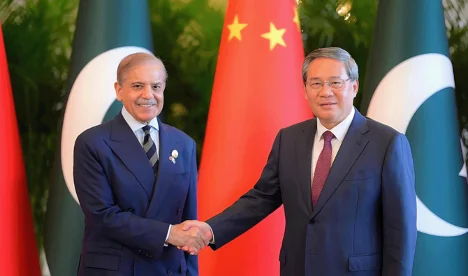Prime Minister Shehbaz Sharif’s visit to Beijing marked a historic moment in Pakistan-China relations with the formal launch of CPEC 2.0. Meeting with Chinese Premier Li Qiang, the two leaders reaffirmed their “iron-clad, all-weather” friendship and set the stage for a bold new phase of the China-Pakistan Economic Corridor (CPEC), which is now evolving from an infrastructure-led development into a comprehensive, diversified economic framework.
Expanding Economic Horizons
At the heart of this upgraded vision are five new development corridors, spanning trade, industry, agriculture, energy, and digital technology, reflecting a strategic shift toward inclusive, long-term growth. The new phase aims to build on CPEC’s first decade of transformative investments in roads, ports, and power generation, projects that significantly alleviated Pakistan’s severe energy shortages and reduced daily power outages from as much as 20 hours to near self-sufficiency.
Now, CPEC 2.0 seeks to deepen economic integration through business-to-business (B2B) investments in priority sectors such as agriculture, which employs nearly 60% of Pakistan’s population, along with information technology, artificial intelligence, mining, textiles, and industry. The creation of Special Economic Zones (SEZs) is central to this effort, designed to attract foreign investment, scale industries, and generate large-scale employment. The visit generated over $8.5 billion in new commitments, comprising around $7 billion in Memoranda of Understanding (MoUs) and $1.54 billion in joint ventures across key sectors such as agriculture, electric vehicles, solar energy, petrochemicals, textiles, health, and advanced technology.
The agreements highlight Pakistan’s determination to attract investment-driven growth and China’s enduring trust in Pakistan’s potential. Equally important was the Pakistan-China Business-to-Business Investment Conference, which brought together more than 800 companies, 500 Chinese and 300 Pakistani, to explore collaborative opportunities. This platform signaled a decisive pivot toward private-sector engagement, ensuring that the benefits of CPEC 2.0 are not limited to government-to-government agreements but also extend to businesses and communities.
Institutional cooperation was further cemented through the signing of the Joint Action Plan 2024–2029, a roadmap designed to streamline implementation, enhance transparency, and ensure accountability in executing projects. This framework will guide Pakistan and China in prioritizing key ventures such as the Main Line-1 (ML-1) railway modernization, Karakoram Highway realignment, and the full operationalization of Gwadar Port, projects central to improving logistics, regional trade, and connectivity.
Technology, Diplomacy, and Regional Integration
CPEC 2.0 also emphasizes technology and innovation, with a focus on artificial intelligence (AI) and IT. Experts project that AI alone could contribute Rs 24.9 trillion (approx. $88 billion) to Pakistan’s economy by 2030, particularly in agriculture, fintech, manufacturing, and mining. The establishment of Special Economic Zones (SEZs) is set to play a central role in attracting industrial relocation, boosting exports, and generating employment across Pakistan.
Diplomatic momentum further strengthened the initiative. In August 2025, Chinese Foreign Minister Wang Yi’s visit to Islamabad reinforced bilateral cooperation, while in March 2025, Beijing rolled over $2 billion in loans to stabilize Pakistan’s economy, an act reflecting China’s confidence in its long-term partnership with Islamabad. Looking ahead, the extension of CPEC into Afghanistan and Central Asia underscores its growing regional dimension, making it not only the flagship of China’s Belt and Road Initiative (BRI) but also a vehicle for broader connectivity, stability, and prosperity across South and Central Asia.
Conclusion
CPEC 2.0 stands as a transformative blueprint for Pakistan’s economic revival and regional integration. With billions in commercial agreements, the launch of Panda Bonds, strategic projects like ML-1 and Gwadar, and cutting-edge investments in IT and agriculture, Pakistan and China are poised to redefine the future of regional connectivity. If implemented with efficiency and inclusivity, this new phase has the potential to deliver lasting prosperity, strengthen Pakistan’s resilience, and cement its role as a hub of trade and innovation in Asia.



